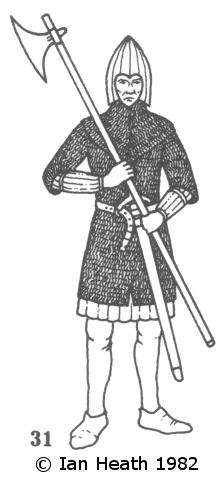
Create an Amazon Business Account
GALLÓGLAICH, 14th-15th CENTURIES
An extract from Armies of the Middle Ages, volume 1by Ian Heath



31. GALLÓGLAICH, 14th-15th CENTURIES
The equipment of gallóglaich under Turlough O'Donnell, King of Tyrconnell 1380-1422, is set down in a 16th century document thus: 'for each man equipped with a mail corselet and a breastplate another should have a jack and a helmet; ... there should be no forfeit for a helmet deficient except the gallóglaich's brain ("dashed out for want of it", as Hayes-McCoy deftly observes); and no fine for a missing axe except a shilling, nor a spear except a groat, which shilling and groat the constable should get.' The jack here referred to is probably in fact a cotun, while the breastplate must have been worn under the corselet since there is no sign of such armour on any of the surviving grave effigies. However, what the effigies do prove is that there were indeed a great many gallóglaich who wore just the cotun, these resembling figure 27 here and figure 53 in Armies of Feudal Europe. The gallóglaich actually depicted here, in cotun and corselet and wearing a helmet very similar to MacMurrough's, is taken from the Burke effigy at Glinsk in County Galway, and probably dates to the late-14th century. His cleanshaven appearance confirms his non-native origin.
Contrary to the impression usually created, not all gallóglaich were armed with axes. In fact early references to gallóglaich axes are rare, the first apparently dating only to 1311. However, the axe (or spar, from 'sparthe') was clearly the principal gallóglaich weapon by the end of the 14th century at the latest. That depicted here comes from Derricke's prints.